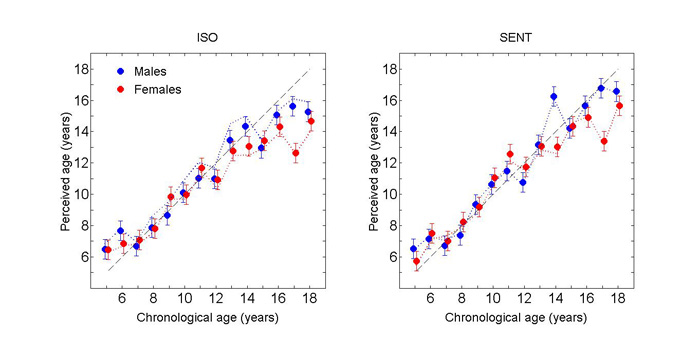
Figure 1: A summary of listener judgments of speaker age as a function of the chronological age of the child
Peter Assmann – assmann@utdallas.edu
School of Behavioral and Brain Sciences
University of Texas at Dallas
Richardson, Texas, USA 75083
Santiago Barreda – sbarreda@ualberta.ca
Terrance M. Nearey – tnearey@ualberta.ca
Department of Linguistics
University of Alberta
Edmonton, Alberta, Canada T6G 2E7
Popular version of paper 2aSC15
Presented Tuesday morning, June 4, 2013
ICA 2013 Montreal
Dramatic changes take place in the voices of children as they get older: the vocal folds increase in length and mass, resulting in lower average voice pitch (fundamental frequency) and the vocal tract becomes larger, resulting in lower resonances (formant frequencies). These age-related changes affect both linguistic and non-linguistic properties of speech, and we are interested in how these properties are perceived by the listener. The perception of age in children’s voices is particularly interesting because age-related acoustic changes in the voice are correlated with substantial changes in physical size.
To study the perception of vocal age, we presented adult listeners with speech sounds spoken by children ranging in age from 5 through 18 years, with equal numbers of boys and girls at each age level. Listeners adjusted a graphical slider on the computer screen to register their estimate of the speaker’s age. The study was designed to answer four main questions:

Figure 1: A summary of listener judgments of speaker age as a function of the chronological age of the child
Figure 1 summarizes listener judgments of speaker age as a function of the chronological age of the child. The circles show the average results for listeners who were not provided with information about the speaker’s sex; error bars indicate variability across listeners (as standard errors). The dotted lines indicate age estimates when information about speaker sex was provided (blue for boys, red for girls). The diagonal indicates perfect performance (perceived age = chronological age). The left panel shows the results for syllables in isolation; results for sentence context are shown on the right. Figure 1 shows that listeners’ age estimates were fairly accurate overall, but there was a systematic tendency to underestimate the ages of the older girls. Age estimates were more accurate for sentences than for syllables, consistent with a recent study by Amir et al. (2012). Informing listeners about the sex of the speaker did not lead to substantially improved age estimation for the isolated syllables, and in fact increased the discrepancy between perceived and chronological age for the voices of older girls.
An important objective of our research is to develop models to predict the perceptual judgments of listeners based on measured acoustic properties of speech. Previous studies have shown that age-related changes in children’s voices are accompanied by large differences in fundamental frequency and formant frequencies, along with changes in overall speaking rate (Lee et al., 1999; Iseli et al., 2007). In addition, there are age-related changes in the mode of vibration of the vocal folds that have subtle yet reliable acoustic consequences. Acoustic measurements related to these properties were obtained from the speech stimuli presented in the experiment and entered into a statistical model to predict listeners’ judgments. The findings indicate relatively accurate predictions of perceived age, and error patterns that are broadly similar to those shown by the listeners.
References
(1) Amir, O., Engel, M., Shabtai, E., & Amir, N. (2012). “Identification of children's gender and age by listeners,” J. Voice 26, 313-321.
(2) Iseli, M., Shue, T.-L. and Alwan A., (2007). “Age, sex, and vowel dependencies of acoustic measures related to the voice source,” J. Acoust. Soc. Am. 121, 2283-2295.
(3) Lee S, Potamianos A, Narayanan S. (1999). “Acoustics of children's speech: developmental changes of temporal and spectral parameters,” J. Acoust. Soc. Am. 105: 1455-1468.